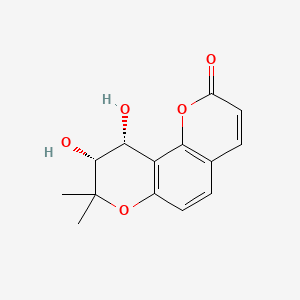QUANTITATIVE ANALYSIS OF KHELLACTONE AND OTHER COUMARINS IN PHLOJODICARPUS SIBIRICUS (APIACEAE)
UDК 582.893.6+547.816.4
Abstract
Phlojodicarpus sibiricus (Fisch.) Koso-Pol. is a medicinal plant of the Apiaceae family, the underground organs of which accumulate various groups of coumarins, including simple coumarins, furocoumarins and angular dihydropyranocoumarins in the form of esters of kellactone (3′,4′-dihydroxy-3′,4′-dihydroseselin), which are the dominant group of secondary metabolites. Known methods for the analysis of rhizomes and roots of P. sibiricus determine the content of individual compounds (visnadin, dihydrosamidin), which does not allow obtaining complete information about the presence of coumarin compounds in the plant. In the present study, a method of quantitative analysis of coumarins was developed. It includes preliminary hydrolysis of raw materials in aqueous potassium hydroxide, which leads to deacylation of esterified derivatives of kellactone and lomatin, without affecting glycosides of simple coumarins, followed by analysis of hydrolysis products (sum of kellactones, lomatin, 6′-O-apiosyl skimmin) by HPLC. The developed technique is characterized by high analysis speed, satisfactory validation characteristics, and accuracy. Approbation of the technique was carried out on samples of rhizomes and roots of P. sibiricus collected in three regions of Siberia (Zabaikalsky Krai, Buryatia Republic, Sakha (Yakutia) Republic). The total content of coumarins in plant materials from the studied populations was 12.70–74.03 mg/g. The method can be used for quality analysis and standardization of P. sibiricus rhizomes and roots.
Downloads
Metrics
References
Venugopala K.N., Rashmi V., Odhav B. Biomed. Res. Int., 2013, vol. 2013, 963248. DOI: 10.1155/2013/963248.
Teng L., Guo X., Ma Y., Xu L., Wei J., Xiao P. J. Ethnopharmacol., 2023, vol. 306, 116129. DOI: 10.1016/j.jep.2022.116129.
Onder A., Nahar L., Cinar A.S., Sarker S.D. J. Herb. Med., 2023, vol. 38, 100625. DOI: 10.1016/j.hermed.2023.100625.
Olennikov D.N., Fedorov I.A., Kashchenko N.I., Chirikova N.K., Vennos C. Molecules, 2019, vol. 24, 2286. DOI: 10.3390/molecules24122286.
Sarker S., Nahar L. Curr. Med. Chem., 2004, vol. 11, pp. 1479–1500. DOI: 10.2174/0929867043365189
Antonova O.K., Shemeryankin B.V. Chem. Nat. Comp., 1982, vol. 17, pp. 588–588. DOI: 10.1007/BF00574388.
Nikonov G.K., Vandyshev V.V. Chem. Nat. Comp., 1969, vol. 5, pp. 101–102. DOI: 10.1007/BF00633290.
Gantimur D., Syrchina A.I., Semenov A.A. Chem. Nat. Comp., 1986, vol. 22, pp. 103–104. DOI: 10.1007/BF00574597.
Georgiyevskiy V.P., Komissarenko N.F., Dmitruk S.Ye. Biologicheski aktivnyye veshchestva lekarstvennykh rasteniy. [Biologically active substances of medicinal plants]. Novosibirsk, 1990, 333 p. (in Russ.).
Mazimba O. Bull. Faculty Pharm., 2017, vol. 55, pp. 223–232. DOI: 10.1016/j.bfopcu.2017.05.001.
Antika L.D., Tasfiyati A.N., Hikmat H., Septama A.W. Z. Naturforsch. C, 2022, vol. 77, pp. 303–316. DOI: 10.1515/znc-2021-0193.
Sarkhail P., Shafiee A., Sarkheil P. BioMed Res. Int., 2013, vol. 2013, 343808. DOI: 10.1155/2013/343808.
Page P.C.B., Appleby L.F., Day D., Chan Y., Buckley B.R., Allin S.M., McKenzie M.J. Org. Lett., 2009, vol. 11, pp. 1991–1993. DOI: 10.1021/ol900444h.
Olennikov D.N. Metabolites, 2023, vol. 13, article 3. DOI: 10.3390/metabo13010003.
Smith E., Hosansky N., Bywater W.G., van Tamelen E.E. J. Am. Chem. Soc., 1957, vol. 79, pp. 3534–3540. DOI: 10.1021/ja01570a062.
Schroeder H.D., Bencze W., Halpern O., Schmid H. Chem. Ber., 1959, vol. 92, pp. 2338–2363. DOI: 10.1002/cber.19590920952.
Willette R.E., Soine T.O. J. Pharm. Sci., 1962, vol. 51, pp. 149–156. DOI: 10.1002/jps.2600510215.
Ikeshiro Y., Mase I., Tomita Y. Phytochemistry, 1992, vol. 31, pp. 4303–4306. DOI: 10.1016/0031-9422(92)80463-o.
Carbonnier J., Molho D. Bull. Mus. Nat. Hist. Nat., 1978, vol. 522, pp. 13–16.
Farmakognoziya. Lekarstvennoye syr'ye rastitel'nogo i zhivotnogo proiskhozhdeniya. [Pharmacognosy. Medicinal raw materials of plant and animal origin]. St. Petersburg, 2009, 863 p. (in Russ.).
Gosudarstvennaya farmakopeya RF XIV izd. [State Pharmacopoeia of the Russian Federation XIV edition]. Moscow, 2018, vol. 4, pp. 5834–6675. (in Russ.).

Copyright (c) 2024 chemistry of plant raw material

This work is licensed under a Creative Commons Attribution 4.0 International License.

This work is licensed under a Creative Commons Attribution 4.0 International License.
The authors, which are published in this journal, agree to the following conditions:
1. Authors retain the copyright to the work and transfer to the journal the right of the first publication along with the work, at the same time licensing it under the terms of the Creative Commons Attribution License, which allows others to distribute this work with the obligatory indication of the authorship of this work and a link to the original publication in this journal .
2. The authors retain the right to enter into separate, additional contractual agreements for the non-exclusive distribution of the version of the work published by this journal (for example, to place it in the university depository or to publish it in a book), with reference to the original publication in this journal.
3. Authors are allowed to post their work on the Internet (for example, in a university repository or on their personal website) before and during the review process of this journal, as this may lead to a productive discussion, as well as more links to this published work.











